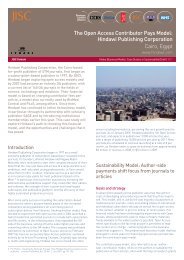A Concise Guide to Researching Audiences - Strategic Content ...
A Concise Guide to Researching Audiences - Strategic Content ...
A Concise Guide to Researching Audiences - Strategic Content ...
Create successful ePaper yourself
Turn your PDF publications into a flip-book with our unique Google optimized e-Paper software.
The <strong>Guide</strong> <strong>to</strong> <strong>Researching</strong> <strong>Audiences</strong><strong>Concise</strong> edition3.3 Choosing the methodologyDifferent approaches <strong>to</strong> audience analysis3.3.1 Audience analysis methods can be categorised in different ways, but the distinction between quantitativeand qualitative methods is an important one. Quantitative methods (eg surveys, web analytics) are usuallymore appropriate when statistically valid conclusions need <strong>to</strong> be drawn about the size, composition andother properties of an audience. Qualitative techniques (eg focus groups, one-<strong>to</strong>-one interviews) may bemore appropriate for exploring attitudes and motivations in depth, discovering patterns of user behaviourand developing a relationship with audience members.3.3.2 Ethnographic or observational techniques (eg diary studies, accompanied browsing) are increasingly usedfor studying usability and patterns of service use. Ethnographic data is often very detailed and may includecomputer collected data which is amenable <strong>to</strong> statistical analysis as well as a qualitative record of userbehaviour.Representative data3.3.3 Samples are said <strong>to</strong> be representative when the composition of the sample audience – with respect <strong>to</strong> allrelevant attributes – is the same as that of the audience as a whole. In some instances it is important <strong>to</strong>obtain data from a representative sample of the audience (eg <strong>to</strong> assess the level of uptake, <strong>to</strong> provideevidence for attainment of key performance indica<strong>to</strong>rs). However, representative data is not always vital,particularly when research is preliminary or explora<strong>to</strong>ry.Selecting appropriate methods3.3.4 The kind of information you want about the audience should help <strong>to</strong> determine the methods you use, butpragmatic considerations (eg time, money, difficulty of recruiting subjects, staff availability and expertiserequired) will inevitably play a part. It is common <strong>to</strong> use a combination of methods in audience analysisprojects, for example quantitative surveys are frequently combined with focus group or interview work.Table 3‐1 provides a guide <strong>to</strong> the methods most likely <strong>to</strong> be useful in researching different aspects of theaudience.Case study extract… Europeana projectA good example of selecting appropriate research methodsEuropeana is a 2-year project <strong>to</strong> design and build a web portal <strong>to</strong> make available <strong>to</strong> users a wealth of digitalobjects (eg pho<strong>to</strong>graphic images, sounds, paintings, maps, manuscripts, books) from museums, libraries andarchives across different European countries.A ‘maquette’ – an animated demonstration website – was initially developed based on user requirements anddetermined in consultation with content providers and technical developers. An audience research projectwas conducted <strong>to</strong> test whether this maquette lived up <strong>to</strong> the expectations and wishes of real end-users interms of functionality, the interface and navigation. This was an important step <strong>to</strong>wards developing a fullyfunctional pro<strong>to</strong>type Europeana site (launched in November 2008).Although the response <strong>to</strong> the demonstration site was generally positive, a number of common concernsemerged. For example, it was found that the home page was not clear enough and did not give a goodintroduction <strong>to</strong> the site; the search results page lacked order in results, level of detail and presentation; andthere was confusion about how the site could be browsed and searched. These results were fed back <strong>to</strong> thetechnical development team working on the fully functional pro<strong>to</strong>type. For further information, please seethe Europeana website (www.europeana.eu).3. Planning audience research PAGE 15



